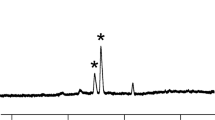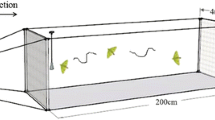Abstract
Numerous species of mirid bugs (Hemiptera: Miridae) are phytophagous insect pests that damage economically important field and horticultural crops. In recent years, Adelphocoris suturalis has become a significant pest in transgenic Bacillus thuringiensis (Bt) cotton fields. We previously reported that virgin A. suturalis females attracted males in the field. In this study, we found that A. suturalis males are not attracted in Y-tube olfactometer bioassays to odors from either live nymphs or sexually mature virgin females whose ostioles of the metathoracic scent gland (MTG) are occluded with paraffin wax. However, males are significantly attracted to odors from adult virgin females when female abdomina are occluded with paraffin, indicating that female A. suturalis release sex pheromones only from the MTG. Volatile extracts from both sexes were collected and analyzed by gas chromatography–electroantennogram detection and gas chromatography–mass spectrometry. We identified (E)-4-oxo-2-hexenal (E4O2H), hexyl hexanoate (HH) and hexyl butyrate (HB) as major components and found that they elicited the largest EAD responses from antennae of males. Both E4O2H and HH were present in aeration extracts from females, while E4O2H was found in males. Capture of only males in field tests using synthetic compounds confirmed the activity of the identified sex pheromone candidates. In the field tests, a 10:1 ratio of the E4O2H and HH binary blend exhibited the highest efficiency in attracting male A. suturalis. Addition of HB to the binary pheromone blend to make a ternary blend did not increase trap catches. These results demonstrate that E4O2H and HH constitute the A. suturalis sex pheromone components.



Similar content being viewed by others
References
Byers JA (1991) BASIC algorithms for random sampling and treatment randomization. Comput Biol Med 21:69–77
Byers JA, Fefer D, Levi-Zada A (2013) Sex pheromone component ratios and mating isolation among three Lygus plant bug species of North America. Naturwissenschaften 100:1115–1123
Cassis G, Schuh RT (2012) Systematics, biodiversity, biogeography, and host associations of the Miridae (Insecta: Hemiptera: Heteroptera: Cimicomorpha). Annu Rev Entomol 57:377–404
Crespo JG, Manrique G (2007) Mating behavior of the hematophagous bug Triatoma infestans: Role of Brindley’s and metasternal glands. J Insect Physiol 53:708–714
Drijfhout FP, Groot AT, Posthumus MA, Van Beek TA, de Groot AE (2002) Coupled gas chromatographic-electroantennographic responses of Lygocoris pabulinus (L.) to female and male produced volatiles. Chemoecology 12:113–118
Fountain M, Jastad G, Hall D, Douglas P, Farman D, Cross J (2014) Further studies on sex pheromones of female Lygus and related bugs: development of effective lures and investigation of species-specificity. J Chem Ecol 40:71–83
Groot AT, Timmer R, Gort G, Lelyveld GP, Drijfhout FP, Van Beek TA, Visser JH (1999) Sex-related perception of insect and plant volatiles in Lygocoris pabulinus. J Chem Ecol 25:2357–2372
Ho HY, Millar JG (2002) Identification, electroantennogram screening, and field bioassays of volatile chemicals from Lygus hesperus Knight (Heteroptera: Miridae). Zool Stud 41:311–320
Hsiao T, Meng L (1963) The plant bugs collected from cotton fields in China (Hemiptera-Heteroptera, Miridae). Acta Zool Sinica 15:439–449
Huang JK, Rozelle S, Pray C, Wang QF (2002) Plant biotechnology in China. Science 295:674–677
Innocenzi PJ, Hall D, Cross JV, Masuh H, Phythian SJ, Chittamaru S, Guarino S (2004) Investigation of long-range female sex pheromone of the European tarnished plant bug, Lygus rugulipennis: chemical, electrophysiological, and field studies. J Chem Ecol 30:1509–1529
Innocenzi PJ, Hall D, Cross JV, Hesketh H (2005) Attraction of male European tarnished plant bug, Lygus rugulipennis to components of the female sex pheromone in the field. J Chem Ecol 31:1401–1413
Kakazaki M, Sugie H (2001) Identification of female sex pheromone of the rice leaf bug, Trigonotylus caelestialium. J Chem Ecol 27:2447–2458
Lowor ST, Del Socorro AP, Gregg PC (2009) Sex pheromones of the green mirid, Creontiades dilutus (Stal) (Hemiptera: Miridae). Int J Agric Res 4:137–145
Lu YH, Wu KM (2008) Cotton mirid bugs and its prevention. Jindun Publisher, Beijing, pp 18–19
Lu YH, Qiu F, Feng HQ, Li HB, Yang ZC, Wyckhuys KAG, Wu KM (2008) Species composition and seasonal abundance of pestiferous plant bugs (Hemiptera: Miridae) on Bt Cotton in China. Crop Prot 27:465–472
Lu YH, Wu KM, Wyckhuys KAG, Guo YY (2009) Potential of mungbean, Vigna radiatus as a trap crop for managing Apolygus lucorum (Hemiptera: Miridae) on Bt cotton. Crop Prot 28:77–81
Lu YH, Wu KM, Jiang YY, Xia B, Feng HQ, Wyckhuys KAG, Guo YY (2010) Mirid bug outbreaks in multiple crops correlated with wide-scale adoption of Bt cotton in China. Science 328:1151–1154
Millar JG, Rice RE, Wang Q (1997) Sex pheromone of the mirid bug Phytocoris relativus. J Chem Ecol 23:1743–1754
Moreira JA, Millar JG (2005) Short and simple syntheses of 4-oxo-(E)-2-hexenal and homologs: Pheromone components and defensive compounds of Hemiptera. J Chem Ecol 31:965–968
Smith RF, Pierce HD Jr, Borden JH (1991) Sex pheromone of the mullein bug, Campylomma verbasci (Meyer) (Heteroptera: Miridae). J Chem Ecol 7:1437–1447
Wu KM, Li W, Feng HQ, Guo YY (2002) Seasonal abundance of the mirids, Lygus lucorum and Adelphocoris spp. (Hemiptera: Miridae) on Bt cotton in northern China. Crop Prot 21:997–1002
Yasuda T, Shigehisa S, Yuasa K, Okutani-Akamatsu Y, Teramoto N, Watanabe T, Mochizuki F (2008) Sex attractant pheromone of the sorghum plant bug Stenotus rubrovittatus (Matsumura) (Heteroptera:Miridae). Appl Entomol Zool 43:219–226
Yasuda T, Oku K, Higuchi H, Shigehisa S, Okutani-Akamatsu Y, Watanabe T, Takahashi A, Sugeno W, Yamashita M, Fukumoto T, Mochizuli F (2009) Optimization of blends of synthetic sex pheromone components for attraction of the sorghum plant bug Stenotus rubrovittatus (Matsumura) (Heteroptera: Miridae). Appl Entomol Zool 44:611–619
Yasuda T, Oku K, Higuchi H, Suzuki T, Kashin J, Kichishima T, Watanabe T, Takedi A, Yasuda M, Tabuchi K, Takahashi A, Yamashita M, Fukumoto T, Mochizuki F (2010) A multi-species pheromone lure: a blend of synthetic sex pheromone components for two mirid species, Stenotus rubrovittatus (Matsumura) and Trigonotylus caelestialium (Kirkaldy) (Heteroptera: Miridae). Appl Entomol Zool 45:593–599
Zhang T (2012) The study of the extraction, identification and application of sex pheromone produced by Apolygus lucorum. http:/www.globethesis.com/?t=1103330335479304
Zhang QH, Aldrich JR (2003a) Pheromones of milkweed bugs (Heteroptera: Lygaeidae) attract wayward plant bugs: Phytocoris mirid sex pheromone. J Chem Ecol 29:1835–1855
Zhang QH, Aldrich JR (2003b) Male-produced anti-sex pheromone in a plant bug. Naturewissenschaften 90:505–508
Zhang QH, Aldrich JR (2008) Sex pheromone of the plant bug, Phytocoris calli Knight. J Chem Ecol 7:719–724
Zhang QH, Chauhan KR, Zhang AJ, Snodgrass GL, Dickens JC, Aldrich JR (2006) Antennal and behavioral responses of Lygus lineolaris (Palisot de Beauvios) (Heteroptera: Miridae) to metathoracic scent gland compounds. J Entomol Sci 42:92–102
Zhang ZL, Luo J, Lu C, Zhao B, Meng J, Chen LZ, Lei CL (2011) Evidence of female-produced sex pheromone of Adelphocoris Suturalis (Hemiptera: Miridae): effect of age and time of day. J Econ Entomol 104:1189–1194
Zhang ZL, Luo J, Wang YN, Chen LJ, Chen LZ, Lei CL (2014) Morphology and chemical analysis of the metathoracic scent glands system in Adelphocoris suturalis (Hemiptera: Miridae). J Insect Sci 14:1–6
Acknowledgements
We thank Dr Joe Hull (Pest Management & Biological Control Research Unit, USDA-ARS, Arid-Land Agricultural Research Center) for the full language editing of this manuscript. We also thank Drs. Weihua Ma and Xiaoyun Wang for improving our manuscript. This work was supported by the Special Fund for Agri-scientific Research in the Public Interest, from the Chinese Ministry of Agriculture (Grant 201103012).
Author information
Authors and Affiliations
Corresponding authors
Additional information
Handling Editor: Günther Raspotnig.
Zhilin Zhang and Tao Zhang have contributed equally to this work.
Rights and permissions
About this article
Cite this article
Zhang, Z., Zhang, T., Zhang, A. et al. Identification and field verification of sex pheromone from the mirid bug, Adelphocoris suturalis . Chemoecology 26, 25–31 (2016). https://doi.org/10.1007/s00049-015-0203-8
Received:
Accepted:
Published:
Issue Date:
DOI: https://doi.org/10.1007/s00049-015-0203-8




